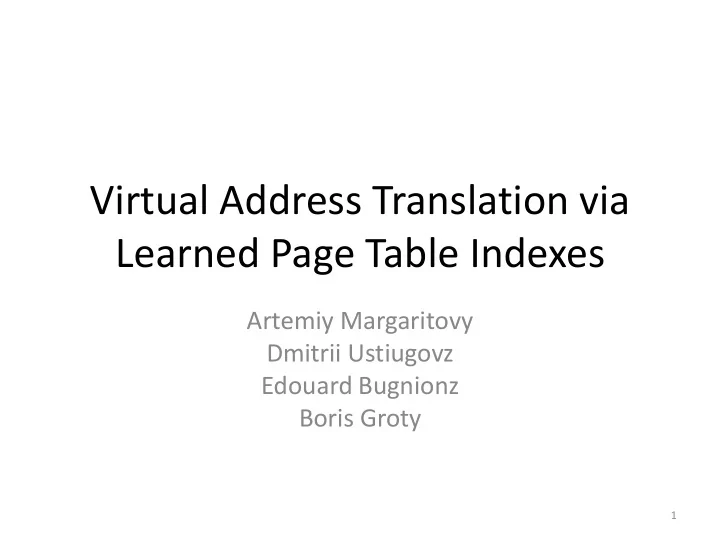

Virtual Address Translation via Learned Page Table Indexes Artemiy Margaritovy Dmitrii Ustiugovz Edouard Bugnionz Boris Groty 1
Learned Address Translation Model • Previous work: • T. Kraska, A. Beutel, E. H. Chi, J. Dean, and N. Polyzotis. The case for learned index structures. SIGMOD, 2018. • A learned model could effectively replace a B+Tree for indexing a sorted key range. 2
Weakness in directly learned model • High inference time in software-based learned models • It is hard to learn the distribution of randomly scatted physical address • If the prediction is wrong, memory leak will happen 3
Proposed method: a more pragmatic strategy Predicted PTE Tag Conventional False Check Page Table (Wrong Prediction) True Last level radix page table Physical Address 4
Proposed method: to accelerate speed • Reduce complexity • Only the page address needs to be predicted (PTE = page addr + offset) • Lowing PTE location prediction accuracy: produce a range of possible locations (multiple PTEs could be fetched in parallel, and memory bandwidth is sufficient) 5
Proposed method: to integrate into modern systems • Pre-defined NN structure. Only weights are determined at application time • Training time could be amortized over the long lifetime of application • Training can occur as a background task when system is idle • Conventional radix page table could be used before NN is trained 6
Quantifying Analysis: Radix Tree • Radix tree: optimized for low latency traversals. Used in memory management in Linux kernel 7
Quantifying Analysis: Software-based learned indexes • 3-level page table • Two-level hierarchy of models: 1 in the first level, and 32 in the second level • The third level is a radix tree page table • Each model: Three layers NN (27 – 32 – 1) • Accuracy: 99.9% 8
Quantifying Analysis: Software-based learned indexes • Not capable for the need of lower-latency learned Index architecture CPU cycles to produce target PTE location 400 350 300 250 200 150 100 50 0 Radix page table learned model learned model 9 with reduced size
Future directions: • Reduced precision -> reduced complexity • Using a microarchitectural learned page table indexer • Binarization of weights and activations -> replace complex multiplication with simpler boolean operators 10
Recommend
More recommend